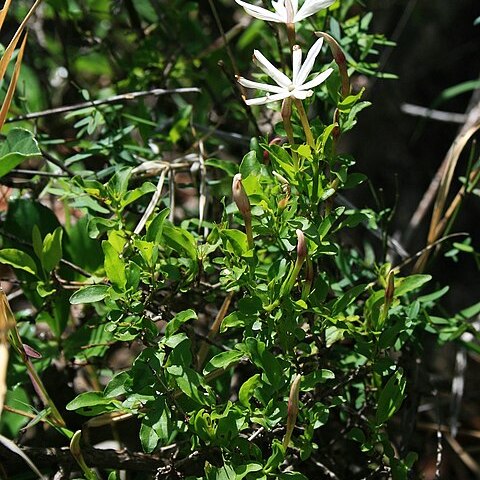Dwarf shrub or climber, 0.3-3.0 m high. Leaves papery, shiny, green, ovate-oblong, apex rounded; 2-5-paired on short twigs, closely spaced; petioles up to 5 mm long, articulated. Inflorescences terminal on lateral twigs, 1-flowered. Flowers scented. Calyx: tube up to 3 mm long; lobes 5-9, subulate. Corolla white, pink-flushed, salver-shaped; tube slender, up to 30 mm long; lobes ± 11, 1/2 tube length. Stamens 2, included; filaments short; anthers ± 3.5 mm long, apiculate. Ovary quadrate, truncate; style exserted; stigma 2-lobed. Flowering time Aug.-May. Fruit a twin berry (one aborting), oblong-globose, black when ripe.
Leaf lamina up to 3 (4·5) x 1·4 (2) cm., but usually much smaller, lanceolate, oblong–elliptic or narrowly ovate, the apex acute to obtuse with minute thickened tip, the base cuneate or tapered; both surfaces glabrous; venation inconspicuous above, midrib more prominent below, lateral nerves few, the basal pair often running almost to the leaf apex; margin of leaf narrowly thickened.
A climber or shrub. It can be 3 m tall. The leaves are opposite and simple. They are narrowly oval and can be 4.5 cm long by 3 cm wide. They are pointed at the tip. The leaves are dark green. The flowers are white and pink underneath. They occur in large groups. They have a scent. The fruit are small and shiny black. The fruit usually have 2 lobes.
Shrub, 0.45-3.00 m high. Twigs shortly, densely and persistently puberulous. Leaves unifoliolate, rarely 3 times as long as broad, petiole articulate in lower half. Calyx lobes almost as long as to much longer than calyx tube. Flowers single on short pedicels, white, pink-flushed or lobes dorsally brick-red.
Corolla white inside, reddish outside; tube 17–32 mm. long; lobes (6) 9–12, (12·5) 15–18 mm. long, oblong, the apex cuspidate, shortly acuminate or trifid.
Stamens inserted near the top of corolla tube; filaments short; anthers 2·5–4 mm. long, reaching to within 2–4 mm. of base of corolla lobes.
Flowers terminal on short lateral branches, solitary or very rarely in 3–flowered cymes, very sweetly scented; pedicels 2–5 mm. long.
Shrub to 3 m, twigs shortly hairy. Leaves ovate-lanceolate. Flowers 1(-3), terminal, ± 11-lobed, white flushed red outside.
Petioles up to 7 mm. long, the articulation variously situated, from near the lamina to near the stem.
Young shoots minutely puberulous, bark of older twigs pale fawn, splitting longitudinally.
Style either well exserted from tube or c. 5 as long, with bifid stigma of variable form.
Calyx tube 2–3 mm. long, glabrous; lobes 7–12, 2·5–5 mm. long, subulate, hispidulous.
Shrub up to 3 m. high, the branches sometimes spreading or sarmentose.
Fruit usually 2–lobed, 7–12 mm. long when dry, each lobe ellipsoid.
Leaves often darkening on drying.
Acarodomatia absent.

